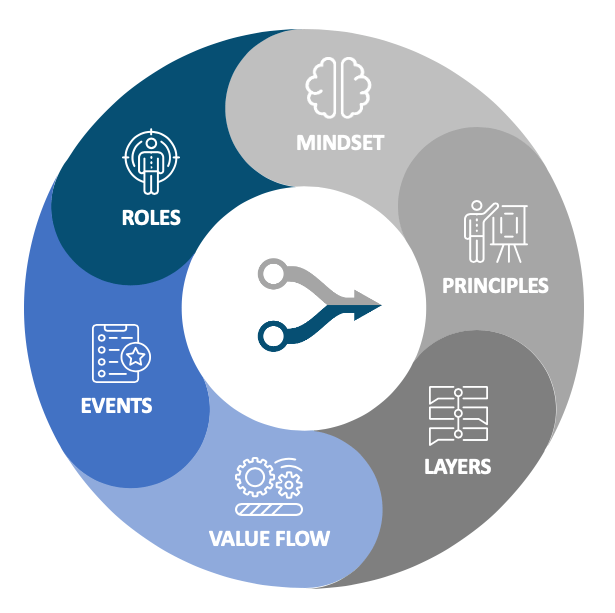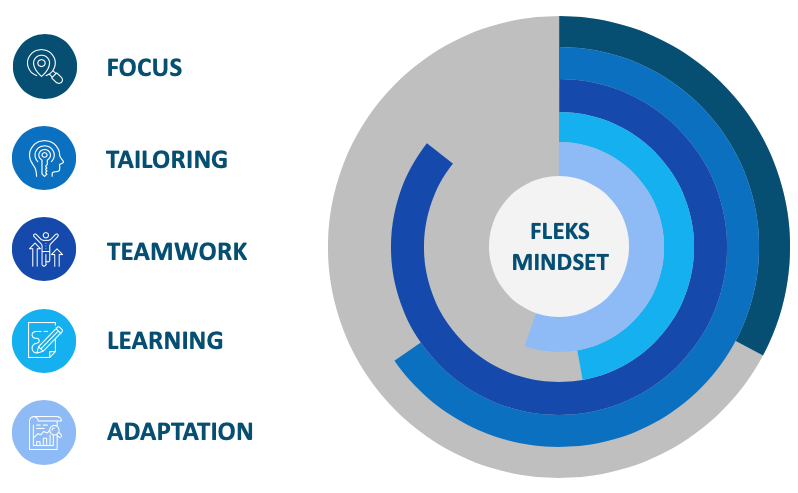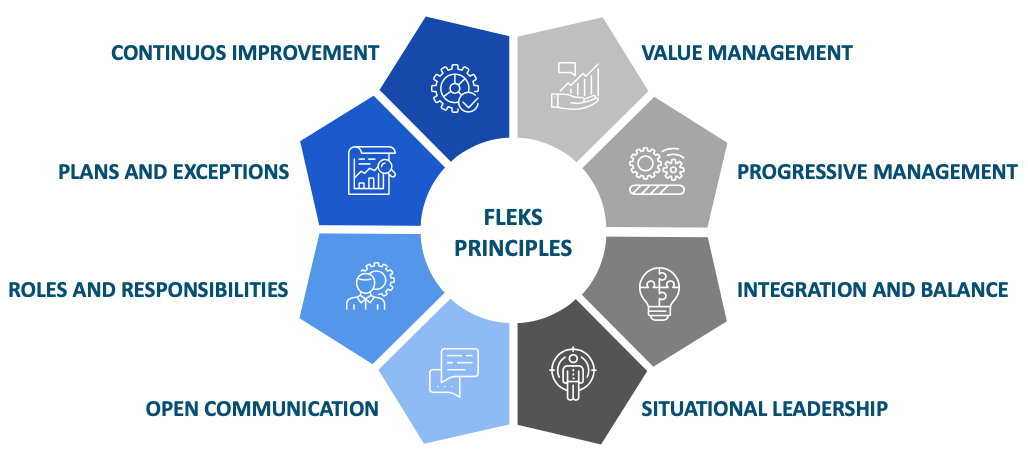I have published some articles that talk about cohabiting predictive and adaptive approaches. I have referred as hybrid approaches to project management.
Today, I will present a new project management model for hybrid environments.
It’s called FLEKS.
This article was written by the creator of the model FLEKS – Hélio Costa, PhD
I am grateful for the generous collaboration of Prof. Hélio Costa and I hope that this article marks the beginning of a profitable discussion about hybrid project management.

Hélio Rodrigues Costa is a former official of the Brazilian Air Force and holds a PhD in Computer Systems Engineering with a focus on Risk Management in Project Portfolio. He also completed his postdoctoral degree in Corporate Risk Management at the University of Quebec in Montreal. With 20 years of experience as a project and portfolio manager, he focused his research, training and consultancy to develop risk management practices, techniques and tools at different levels.
FLEKS MODEL
FILLING THE GAP BETWEEN PREDICTIVE AND ADAPTIVE APPROACHES
Hybrid Project Management
Hybrid Project Management is a broad area of study where organizations and project teams apply processes, techniques, tools and practices from different approaches (predictive and/or adaptive). The idea is to take advantage of the approaches and create a better way to manage projects, develop products and reach goals.
The approaches can be combined in different ways. The figures below display some of these combinations.
It is possible to apply only different predictive approaches at the same time or even only different adaptive approaches. In this case, this is considered a hybrid approach but only predictive or only adaptive, like the images below.

On the other hand, it is possible to combine adaptive and predictive approaches. In the first case, the approaches are used one after the other, due to project characteristics such as uncertainties, dependencies and resources. The image shows the adaptive approach first, but the order can be switched.

In this situation, the project is mainly developed with a predictive approach and some parts are performed with an adaptive approach.

On the other hand, the project can be mainly developed with an adaptive approach and some parts are done with a predictive approach.
.

Finally, both approaches can be used at the same time throughout the project.
.

All possibilities have advantages and disadvantages and the organization must adapt to the project characteristics and needs.
The FLEKS Model
The FLEKS model comprises six elements to guide practitioners through its use. The model was created to be as flexible as possible, but it is assumed that the concepts presented in this guide should be followed in order to provide the best results and lead teams and organizations to success.
The elements are: MINDSET, PRINCIPLES, LAYERS, EVENTS, VALUE FLOW AND ROLES. Each one carries its share of importance and their understanding is paramount to those aiming to use the model.

Mindset
FLEKS advocates five different attitudes to facilitate the development of the desired mindset: focus, tailoring, teamwork, learning and adaptation.

- Teams need FOCUS to get better performance and deliver the best products at a sustainable speed.
- TAILOR and lean the processes as much as possible without compromising desired control.
- TEAMWORK is the key to keep people united and committed to reaching goals.
- The team must LEARN as much as possible to improve quality and promote growth.
- Measuring and getting feedback are the fastest way to ADAPT.
Principles
FLEKS has some principles considered sine qua non to help the management process in the challenge to lead people, create value and conduct projects to its goals.

- VALUE MANAGEMENT: value creation is the project’s main driver and must always be pursued.
- PROGRESSIVE MANAGEMENT: planning, execution and control per release helps to gain knowledge and minimizes risks.
- INTEGRATION AND BALANCE: integrate and balance all value elements to deliver products according to priority.
- SITUATIONAL LEADERSHIP: managers must adapt leadership actions according to the context.
- CONTINUOUS IMPROVEMENT: lessons learned must be applied in order to improve management processes.
- PLANS AND EXCEPTIONS: plans must have a degree of flexibility/tolerance in order to face uncertainties and help decision making.
- ROLES AND RESPONSIBILITIES: the whole team know their roles and responsibilities and are committed to it.
- OPEN COMMUNICATION: communication channels must be open to facilitate information exchange and transparency.
Layers
FLEKS defines three management layers to draw a distinction between roles and responsibilities which are collaborative and interdependent. The layers also allow a better understanding of what are the main elements responsible for creating value.
Business Management Layer
This layer is responsible for the business part of the project. The Business Manager is accountable for this layer but is not the only one responsible for executing the activities planned for the layer.
Project Management Layer
This layer is responsible for planning the project’s execution and control as well as its main components. The Project Manager is accountable for this layer, but he can be helped by the Product Manager or specialists to contribute with their expertise.
Product Management Layer
This layer is responsible for developing the agreed project products or adapting them. The person accountable for this layer is the Product Manager, working closely with the Development Team and responsible for all activities performed at this level.
Value Flow
FLEKS is an iterative, incremental and recursive value creation process.
Iterative means repeated with incremental cycles that are conducted in small portions at a time, allowing the team to take advantage of what was learned and improve the process.
Recursive is a method of solving a problem where the solution depends on solutions to smaller instances of the same problem, generally using iterations.
The idea is to represent a problem in terms of one or more smaller problems and add one or more base conditions that stop the recursion.
Events
Throughout the management layers and the value flow, several events are prescribed and must take place to ensure the process starts and finishes properly. Some of them are time-boxed and some are not, due the nature of the event and the project itself.
Each event is designed to allow for people interaction, collaboration and learning. The events can be divided into three main groups:
- BUSINESS: those carried out on the Business Management Layer.
- PROJECT: those carried out on the Project Management Layer.
- PRODUCT: those carried out on the Product Management Layer.
Roles
The project team is responsible for planning, executing and controlling all activities related to the project, putting in practice the mindset, principles and their personal skills and knowledge for the project’s success.
Each team member has different responsibilities and distinct roles, but they must bear in mind that they are a team and, as such, they have to act and keep their commitment.
The project team is composed of the following roles:

Business Manager
The Business Managers are ultimately accountable for the project, creating a link between the project and the business goals.
Project Manager
The Project Manager is accountable for planning and controlling the project on a daily basis on behalf of the Business Manager and within the parameters defined by the Business Case.
Product Manager
The Product Manager is the person responsible for coordinating product development and delivering the value proposed by the project.
Development Team
The Development Team is responsible for planning, executing and controlling all activities deemed necessary to create the products and for delivering each iteration value.
Want to know more about FLEKS?
Register for our next FLEKS TRAINING
If predictive approaches are too much for you. If adaptive approaches are not enough. What about a hybrid alternative?
FLEKS is a Hybrid Project Management Model that will fill the gap beween predictive and adaptive approaches.
Did you like it?
share it Didn’t you like it?
comment or leave your thoughts to improve it

Download your FREE ebook 'HOW TO BE A GOOD PROJECT MANAGER'
Best advices from 30 TOP influencers in project management

